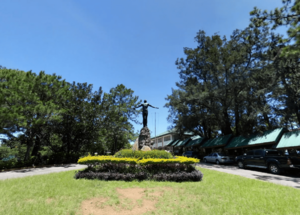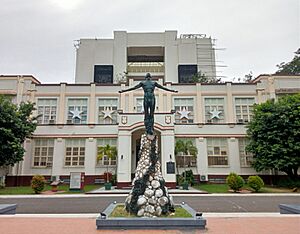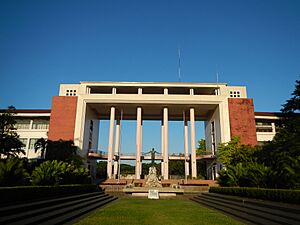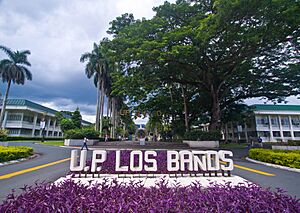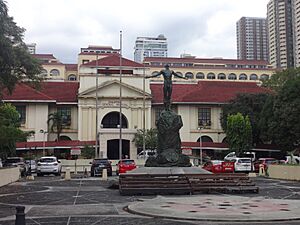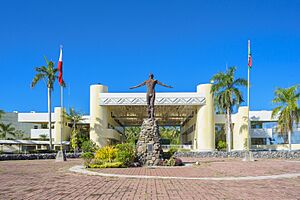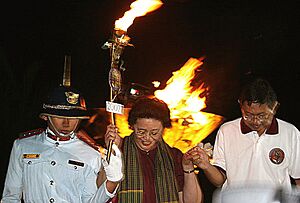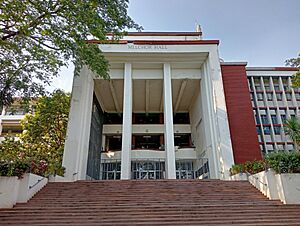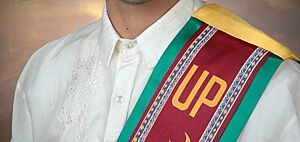University of the Philippines facts for kids
|
|
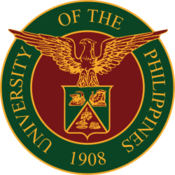 |
|
| Motto | “Honor, Excellence, Service” |
|---|---|
| Type | Public coeducational non-profit research higher education institution and national university system |
| Established | June 18, 1908 |
|
Academic affiliations
|
|
| Budget | ₱24.392 billion (US$ 477 million) (2022) |
| Chairperson | Shirley Agrupis |
| President | Angelo Jimenez |
|
Academic staff
|
4,172 (2022) |
| Students | 64,144 (2022) |
| Undergraduates | 44,861 (2022) |
| Postgraduates | 19,283 (2022) |
|
Other students
|
2,757 (basic level) (2022) |
| Location |
Diliman, Quezon City, Philippines (main campus)
14°40′N 121°04′E / 14.667°N 121.067°E |
| Campus | Multiple sites, 26,304.5416 ha (64,999.938 acres) |
| Alma Mater song | "U.P. Naming Mahal" ("U.P. Beloved") |
| Colors | |
| Nickname | Fighting Maroons |
| Mascot | Oble |
| UP Naming Mahal | |
|
Choral version arranged by Nhick Pacis and performed by the UP Concert Chorus
|
|
The University of the Philippines (UP) is the national university system of the Philippines. A law called the UP Charter of 2008 officially named it the country's national university. This means it has the freedom to make its own decisions.
UP was founded on June 18, 1908, by the American colonial government. The goal was to create a top university for "advanced instruction in literature, philosophy, the sciences, and the arts." It was also meant to provide professional and technical training to everyone, no matter their age, gender, nationality, or beliefs.
The first UP schools were in Manila and Los Baños, Laguna. In 1949, the university expanded to a large campus in Diliman, Quezon City. This became the main campus. Today, UP is a system of eight universities and one college spread across 17 campuses all over the Philippines.
Contents
History of the University
How UP Began (1900s–1940s)
The University of the Philippines was officially created on June 18, 1908. The law that created it, called the "University Act," said its job was to teach advanced subjects and provide professional training.
The first colleges to open were the College of Agriculture (1909) and the College of Veterinary Medicine (1910) in Los Baños. In Manila, the School of Fine Arts (1909) and the College of Medicine and Surgery (1910) were started. Soon after, the colleges of Liberal Arts, Engineering, and Law were also founded in Manila.
As the university grew, it needed more space. It bought a huge piece of land in Diliman, Quezon City. Construction on this new campus began in 1939.
During World War II, many colleges had to close. The Japanese Imperial Army used some of the buildings on the Diliman and Los Baños campuses. After the war, a big effort was made to rebuild and repair the university. New buildings were constructed on the Diliman campus, which became the new heart of UP.
Growth and New Ideas (1950s–1990s)
In the 1960s, under President Carlos P. Romulo, UP added many new centers and institutes. These included the Institute of Mass Communication and the College of Business Administration.
In 1982, UP Diliman officially became its own university within the UP System. In 1987, President José Abueva started the Socialized Tuition Fee Assistance Program (STFAP). This program helped students from lower-income families afford to study at UP.
Later, President Emil Javier established U.P. Mindanao in Davao City and the U.P. Open University in 1995. The Open University allows people to study from a distance.
Celebrating 100 Years
On January 8, 2008, UP began its 100th anniversary celebration. The opening ceremony included a relay of 100 torches to light a Centennial Cauldron. The cauldron had three pillars for UP's values: Honor, Excellence, and Service. It also had seven flowers for the seven universities in the system at the time.
To celebrate, the Bangko Sentral ng Pilipinas (the central bank of the Philippines) released special ₱100 bills with the UP Centennial logo.
The UP Charter of 2008
A new law, the U.P. Charter of 2008, was signed on April 29, 2008. This law officially declared UP as the Philippines' national university. It gave the university more freedom to manage its own affairs and budget. This helped UP improve its ability to serve the country.
The Different UP Universities
The University of the Philippines is made up of eight separate universities, called constituent universities (CUs), and one autonomous college. Each one has a leader called a chancellor.
| University | Chancellor | Founded | What It's Known For | Description |
|---|---|---|---|---|
| University of the Philippines Baguio | Prof. Joel M. Addawe | 1961 | Social Sciences, Arts, Communication, Natural Sciences | Northern Luzon's center for science and culture. |
| University of the Philippines Cebu | Atty. Leo B. Malagar | 1918 | Information Technology, Arts, Sciences | UP’s center for creativity and new ideas in the Central Philippines. |
| University of the Philippines Diliman | Atty. Edgardo Carlo Vistan II | 1949 | Arts, Humanities, Social Sciences, Natural Sciences, Engineering, Business | UP's main university for liberal arts and scientific research. The central administration for the whole UP system is here. |
| University of the Philippines Los Baños | Dr. Jose V. Camacho, Jr. | 1909 | Agriculture, Food Science, Forestry, Veterinary Medicine, Natural Sciences | A top university for agriculture and science. It takes care of the famous Mount Makiling. |
| University of the Philippines Manila | Dr. Michael L. Tee | 1908 | Health Sciences, Medicine, Nursing, Pharmacy | The Philippines' top health sciences center. It runs the Philippine General Hospital. |
| University of the Philippines Mindanao | Prof. Lyre Anni Murao | 1995 | Humanities, Social Sciences, Agribusiness, Data Science | UP's main campus in the south, focusing on science and culture in Mindanao. |
| University of the Philippines Visayas | Dr. Clement Camposano | 1947 | Fisheries, Ocean Sciences, Technology | A leading university in the Visayas, known for its work in fisheries. |
| University of the Philippines Open University | Dr. Joane V. Serrano | 1995 | Distance Education, Management, Communication | UP’s expert in online and distance learning. |
Autonomous College
On April 27, 2023, UP Tacloban became an autonomous college. This means it has more freedom to operate on its own, instead of being a part of UP Visayas. This change helps the college better serve the Eastern Visayas region.
| College | Dean | Founded | What It's Known For | Declared as Autonomous Unit |
|---|---|---|---|---|
| University of the Philippines Tacloban | Dr. Patricia Arinto | 1973 | Humanities, Management, Social Sciences, Natural Sciences | April 27, 2023 |
Basic Education
UP also has high schools connected to some of its universities:
- University of the Philippines High School Cebu (in UP Cebu)
- University of the Philippines High School Iloilo (in UP Visayas)
- University of the Philippines Integrated School (in UP Diliman)
- University of the Philippines Rural High School (in UP Los Baños)
How UP is Organized
| Presidents of the University of the Philippines |
| Murray S. Bartlett, 1911-1915 |
| Ignacio B. Villamor, 1915-1921 |
| Guy Potter Wharton Benton, 1921-1925 |
| Rafael V. Palma, 1925-1933 |
| Jorge Bocobo, 1934-1939 |
| Bienvenido Ma. González, 1939–1943, 1945-1951 |
| Antonio Sison, 1943-1945 |
| Vidal A. Tan, 1951-1956 |
| Enrique Virata, 1956-1958 |
| Vicente G. Sinco, 1958-1962 |
| Carlos P. Romulo, 1962-1968 |
| Salvador P. Lopez, 1969-1975 |
| Onofre D. Corpuz, 1975-1979 |
| Emanuel V. Soriano, 1979-1981 |
| Edgardo J. Angara, 1981-1987 |
| José Abueva, 1987-1993 |
| Emil Q. Javier, 1993-1999 |
| Francisco Nemenzo, Jr., 1999-2005 |
| Emerlinda R. Roman, 2005–2011 |
| Alfredo E. Pascual, 2011–2017 |
| Danilo Concepcion, 2017–2023 |
| Angelo Jimenez, 2023–present |
The UP President
The President of the University of the Philippines is the leader of the entire UP system. They are elected for one six-year term. The current president is Angelo Jimenez, who started his term on February 10, 2023.
The Board of Regents
The Board of Regents (BoR) is the highest decision-making group in the UP system. It has 11 members who govern the university.
The board includes the head of the Commission on Higher Education (CHED), the UP President, and leaders from the Philippine Senate and House of Representatives. It also has members who represent students, faculty, staff, and alumni.
Studying at UP
The University of the Philippines System offers more than 200 undergraduate degree programs and over 350 graduate degree programs. This is more than any other university in the country.
UP is known for being a top university. It is consistently ranked as the number one university in the Philippines. Many of its programs, like Engineering, Medicine, and Agriculture, are recognized as "Centers of Excellence."
Getting into UP
Getting into UP is very competitive. Over 70,000 students take the entrance exam, called the University of the Philippines College Admission Test (UPCAT), each year. Only about 11,000 are accepted.
Admission is based on the student's UPCAT score and their grades from high school. UP also has a policy to make sure its students come from all parts of the country and from different backgrounds.
Socialized Tuition System
UP has a Socialized Tuition System (STS). This program adjusts the tuition fee based on a student's family income. This helps make a UP education affordable for students from all financial backgrounds. Students with lower incomes may pay less or even receive financial aid.
University Symbols and Traditions
Colors and Seal
The university's official colors are maroon and forest green. Maroon represents the fight for freedom. The colors are mentioned in the university hymn, U.P. Naming Mahal.
The official seal of UP has an eagle holding a shield. The shield has symbols for science and medicine (a lamp), engineering (a cogwheel), and agriculture (a volcano and a tree). These fields are areas where UP is known to be a leader.
U.P. Naming Mahal
U.P. Naming Mahal is the university's official hymn. The music was written by Nicanor Abelardo, a famous Filipino musician and UP alumnus. Students and alumni sing the hymn at official events to show their love and loyalty to the university.
The Sablay
Instead of a traditional cap and gown, UP graduates wear a special sash called the Sablay. The Sablay has the university's initials written in the ancient Filipino script called Baybayin. It also features designs inspired by indigenous Filipino patterns.
During the graduation ceremony, students wear the Sablay on their right shoulder. After their degree is officially given, they move it to their left shoulder.
Notable People from UP
Many famous and important people in the Philippines are graduates of the University of the Philippines.
- Philippine Presidents: José P. Laurel, Ferdinand Marcos, and Gloria Macapagal Arroyo.
- Political Leaders: Former Vice President Leni Robredo and senators like Jovito Salonga and Ninoy Aquino.
- Chief Justices: Former leaders of the Supreme Court like Hilario Davide and Maria Lourdes Sereno.
- Business Leaders: Jorge L. Araneta of the Araneta Group and Antonio Quirino, who founded the first TV station in the Philippines (now ABS-CBN Corporation).
- Nobel Prize Winner: Maria Ressa, a journalist who won the Nobel Peace Prize in 2021.
See also
 In Spanish: Universidad de Filipinas para niños
In Spanish: Universidad de Filipinas para niños
- DZUP 1602
- Higher Education In The Philippines


